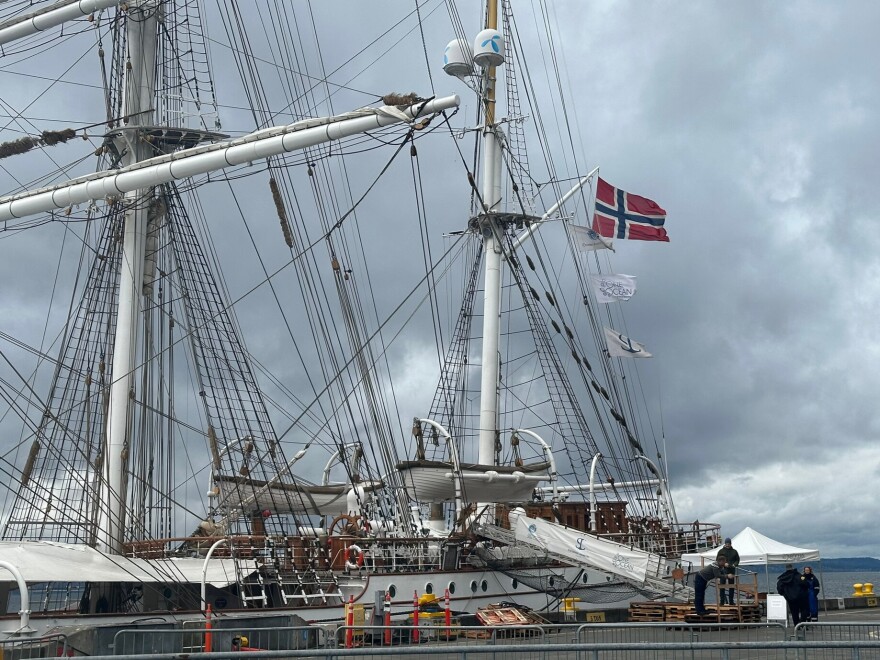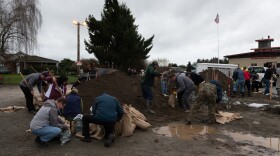New technology is often central to solutions for how humanity will survive as the climate changes. But tools from the past can help provide the most enduring answers.
Those two perspectives come together on board the Statsrad Lehmkuhl, a tall ship built in 1914 as a training vessel for Germany’s merchant marines.
Its home port is in Bergen, Seattle's Norwegian sister city. But right now, it’s on a global mission to promote awareness about the state of the oceans in a time of drastic climate change. Oceans cover over two thirds of the planet, are vital to trade, and are a major carbon sink.
For the second time, the ship is circumnavigating the globe on a mission called One Ocean. It is recognized by the United Nations, as part of the UN One Ocean Decade for Sustainable Development.
The Statsraad Lehmkuhl is a square-rigger with three masts, the tallest soaring 157 feet above the deck, which is more than 300 feet long – almost as long as a standard American football field.
Sail trainees at dozens of ports have paid to come aboard and learn how to sail.
This steel ship is mainly powered by wind in its enormous sails. But it is also a testing ground for many other technologies that have been added on, such as advanced sensors that collect detailed ocean data in real time.
Those measurements include variables such as salinity, oxygen levels, acidity, temperature and currents, as well as the presence of certain organisms.
The ship has special equipment that captures information about the water to analyze DNA traces and microplastics. And they are contributing to scientific research by charting the data as they sail.
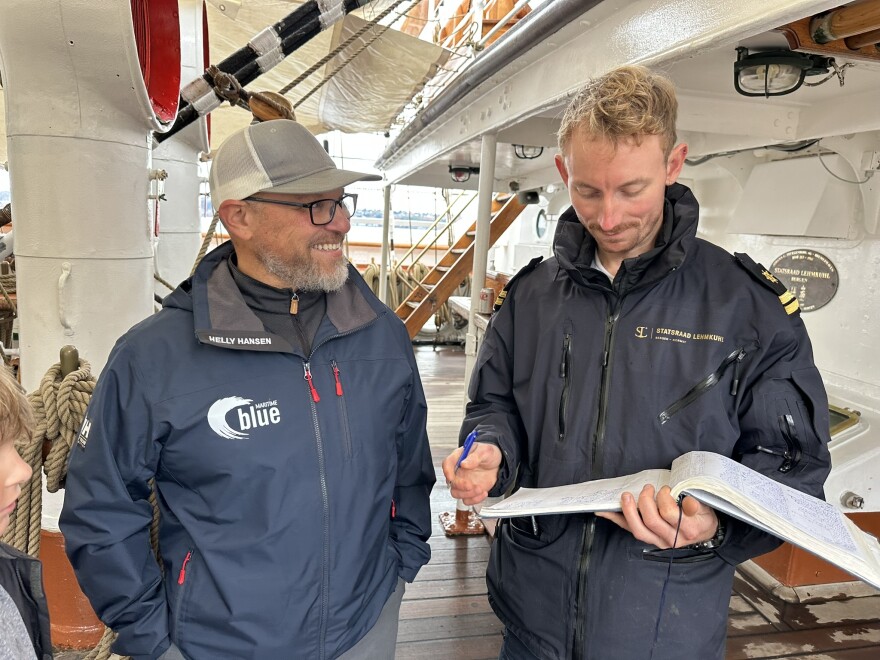
Seattle’s tall ship connections
Docking in Seattle at the end of October, the world-renowned ship touched the west coast of the continental U.S. for the first time. The Statsraad Lehmkuhl’s crew had planned to sail here via Southeast Alaska but had to skip that stop and reroute through the Panama Canal. Canadian authorities said the warming climate had created dangerous ice flows, making the legendary route through North America’s Inside Passage too dangerous to navigate.
While many factors led to the historic moment, one man in particular gets credit for bringing the ship here: Joshua Berger.
For years, Berger was one of two captains of Washington’s historic schooner, the Adventuress. He could hardly contain his excitement about the Statsraad Lehmkuhl’s landing.
“From the perspective of a tall ship sailor, this is the most beautiful, fastest, remarkable tall ship in the whole global fleet of tall ships,” he said.
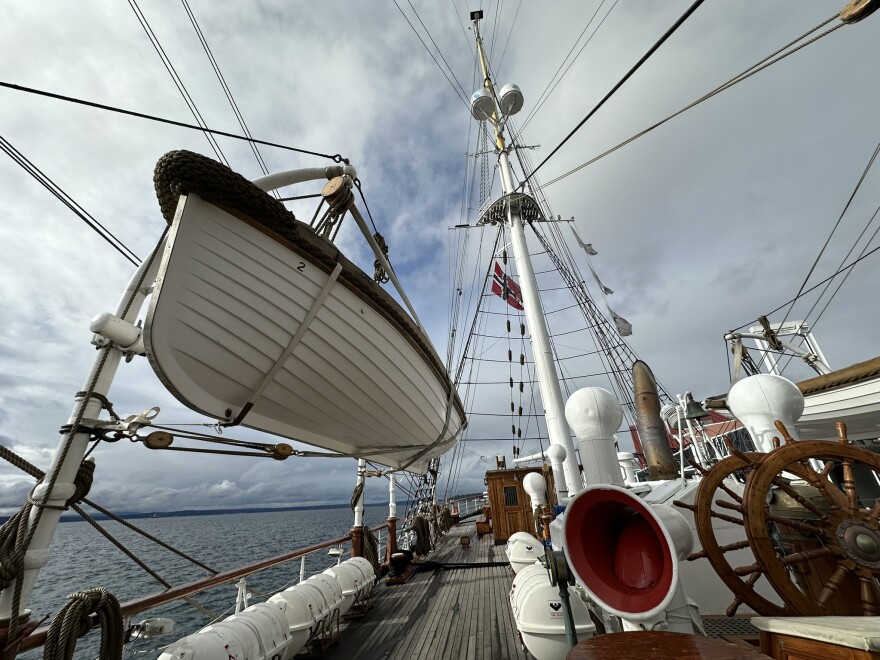
Berger is the founder, president and CEO of a nonprofit called Maritime Blue. It’s working to accelerate the sustainability of the maritime sector with things like hybrid-electric ferries, new batteries and AI. And he is thrilled that the mission of the Statsraad Lehmkuhl — to collect scientific data from the ocean — aligns with his.
Berger is focused on climate solutions, and he’s adamant that the ocean holds many answers: “It is responsible for every other breath we take, the oxygen that we have in this atmosphere.” But it’s not just technological innovation. Berger believes people need to find new ways of doing and being, and that there’s no better place to foster that kind of resourcefulness than on a tall ship.
“You have to work together,” he said. “You have to know how your shipmate is doing. You have to know how your vessel is doing. You have to know what the wind and weather is going to do, and you have to be the sort of orchestrator of a whole system.”
Berger knows this firsthand. Two years ago he took his daughter Esme, then 13 years old, out of school for two months so they could experience life aboard the tall ship together. He worked as a teacher, and Esme joined the crew to help sail the ship across the Indian Ocean, from Singapore to Mauritius in Africa.
Esme, now 16, gave a tour of the ship when it was docked in Seattle. As she walked around the benches on the deck where sailors sleep and showed how they stow hammocks and gear, she, too, could hardly contain her enthusiasm for the ship.
“It was such a beautiful experience,” she said. “There were so many times — I think weeks — that you couldn't see anything around you except for a circle of water. It was the most amazing experience ever. And I'm so, so excited to do another little leg on this boat again.”

Sailing to San Francisco, she was once again the youngest of the 63 sail trainees on board. The oldest in the Seattle delegation was 80 years old. Their ranks included engineers, nurses and people whose families sailed.
Along with the beauty of the ocean and the value of hard work in close quarters, Esme said there’s something spiritual about being on board — even for someone like her, who started sailing with her parents in utero.
“It connects you with the water. It connects you with your community,” she said. “It's so amazing to be able to go down and make friends and sleep in tiny little hammocks, where, if the waves go then you, like, crash in next to them, and then you wake up super early, and you stare at the ocean, and you watch the logs pass by, and you watch yourself move. It's something that you can't really simulate.”
That’s a sentiment Statsraad Lehmkuhl’s chief engineer Morten Thøgersen,
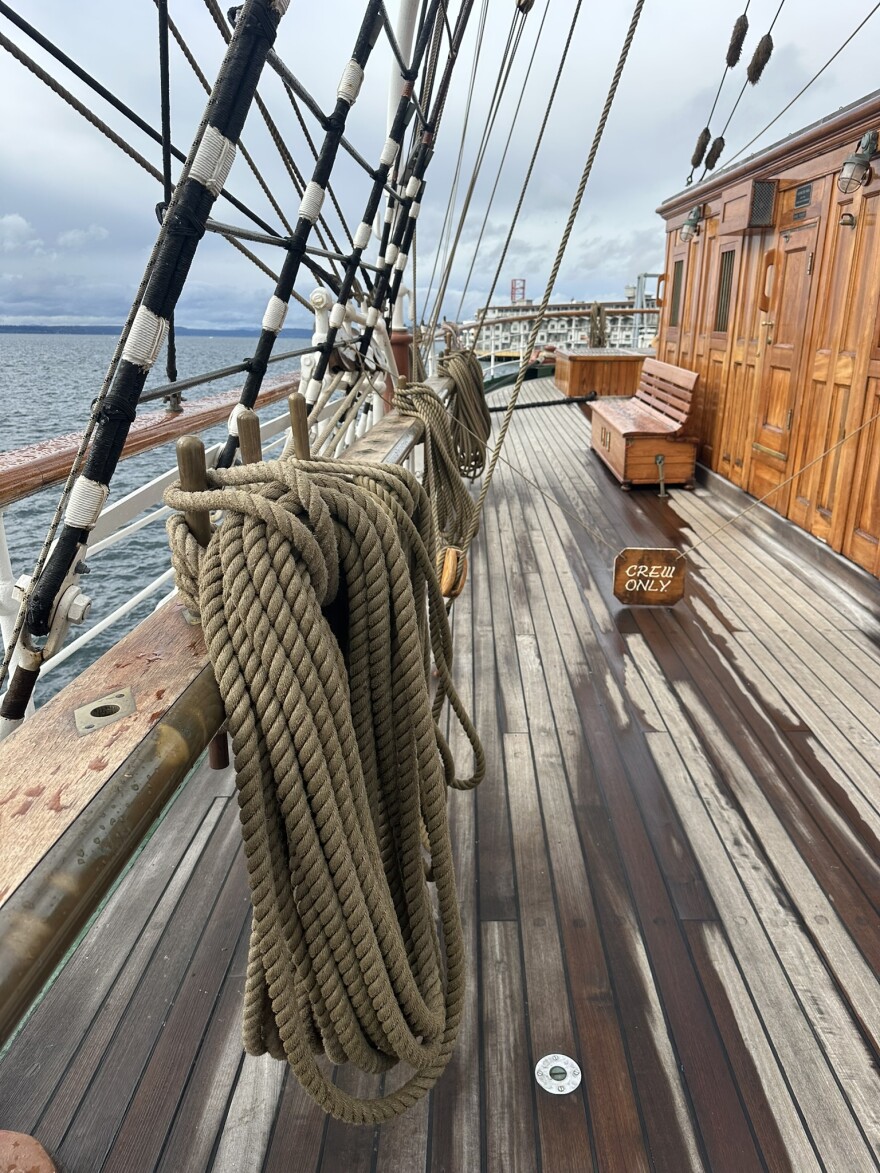
33, agreed with. During a tour of the ship while it was docked at Pier 66 in Seattle, he said he quit more lucrative work as a merchant marine to join the permanent crew here.
“I have been sailing since I was a small kid,” Thøgersen said. “And yeah, you could say a childhood dream come true, being able and having the opportunity to sail on these very beautiful ships. It’s just very nice.”
The crew aims to use the sails at least 70% of the time, but they still need the old diesel engines, especially when maneuvering in and out of ports.
Thøgersen led the way down three flights, past a couple of big fire extinguishers, to the engine room, where large fans hummed, keeping a huge stack of electric batteries cool. He said they’re increasingly relying on the batteries, which are mostly used to power the lights on board.
“We can also use it to propel the ship, but for a very limited amount of time,” he said.
Further on, in the ship’s classroom, Thøgersen pointed to a diagram on the wall and explained that the Statsraad Lehmkuhl has a hybrid motor system built by Rolls-Royce. It helps recharge the batteries whenever the propeller spins.
“We have a hybrid shaft generator on board which we can use to produce electricity while the main engine is running,” he said. That means the engine is almost always giving energy back to the battery stack.
Thøgersen said they would need much larger batteries to run on electricity
all day, say, for an Atlantic crossing. And there isn’t really space for them with the ship’s classroom, which is on the same floor as the engine room and large enough for about 20 people.
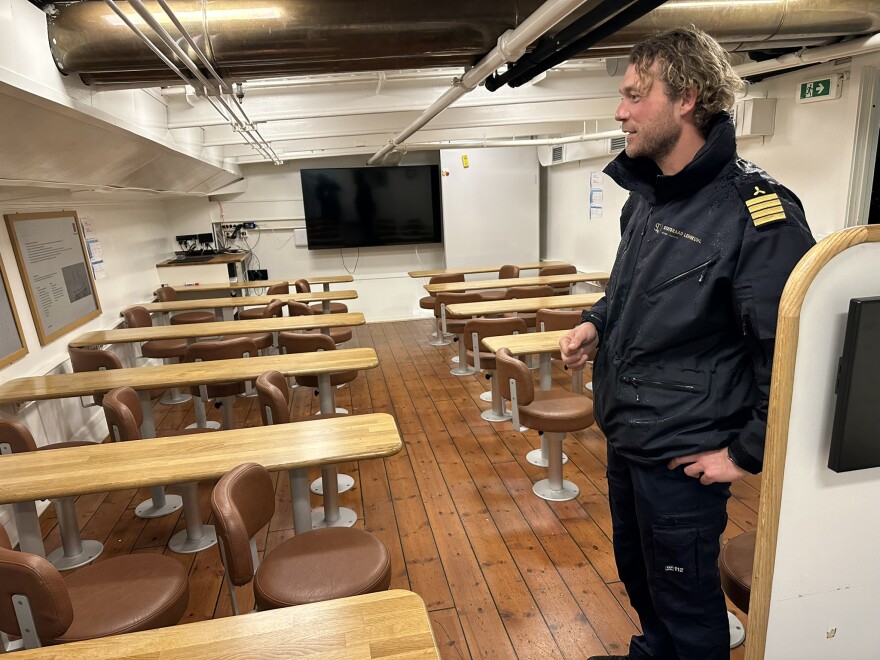
One Ocean mission
The Statsraad Lehmkuhl is now a research vessel as well as a place of instruction. Two years ago, it circumnavigated the globe as part of a United Nations mission, collecting water samples and other data. Now it is on its second global voyage.
University of Washington oceanographer Jan Newton led a group of students and staff who joined one leg of the journey in Seattle.
Newton started dreaming about the idea two years ago, after she toured the ship at its home port in Bergen during a conference about the effects of climate change on the world's oceans.
Newton was enchanted by the ship, and told the captain to come to Seattle. He told her there was already a good chance that would happen. So when Berger started organizing, Newton put out an open call to recruit participants from the University of Washington.
“We're really excited to join the ship and the science that Statsraad Lehmkuhl is already doing,” Newton said prior to setting sail. “The students will be looking at those data, both during our cruise but also where the ship has been prior to now, so it's going to be a really rich experience.”
The students will look at images of phytoplankton and other tiny species as they flow by to learn about ocean health. These tiny organisms are the foundation of the marine food web, Newton said. Over the years, much of her work has relied on federal funding, which has recently become much less certain. Newton, who is also director of the Northwest Association of Networked Ocean Observing Systems, said she is very concerned about the continuity of scientific research and data sets moving forward. Still, getting some data from this ship helps, at least a bit.
“We understand this isn't going to happen every month or every year, but it's really valuable that it's happening around the world,” Newton said, adding that even the simple mission of raising awareness of the state of the oceans in the face of the warming climate is vital.
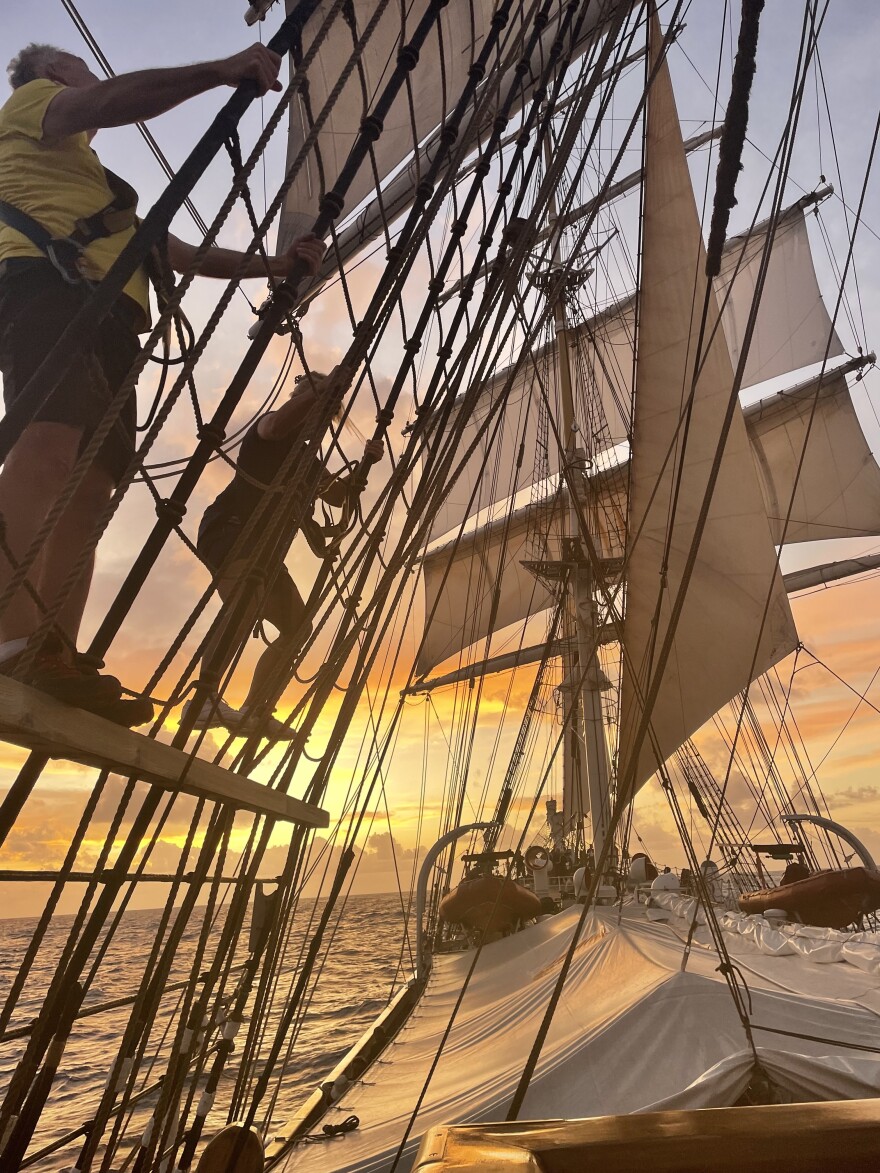
Newton said bringing students with her shows what can be done city to city, ship to ship — even without federal support.
Many of the trainees said being on board makes them aware of all the things we take for granted on land. The ship’s engineer, Morton Thurston, described it as a small town.“We have to produce electricity, drinking water, sewage treatment, you know, everything,” he said. “It's an eye opener for a lot of people. They learn that everything comes at a price.”
Newton, who has done a lot of scientific research at sea, likes pitching in.
“I've sailed with captains that said, ’Every day, just do a little bit of something for the ship, and she'll take care of you.’ And I think that's such a great philosophy, whether we're thinking of the ship or planet Earth or the ocean, just being mindful of that,” she said.
On their journey from Seattle to San Francisco, they faced 20-foot waves off the coast of Washington for about 36 hours. Lots of people, including some of the permanent crew, got seasick.
They didn't get to use the sails as much as they had hoped. But they still worked in three shifts of eight hours each, taking turns at watch on deck.
“When you're hauling on a line at 4 a.m., you know, you really connect with people in a different way,” Newton said. “Everybody had their own passion and appreciation for the ocean and for the ship and very much united. So it was an extraordinary experience.”
Newton said that experience is just one of many; she shares the observations of her fellow-travelers on a blog. Still, she said, being off the grid with no Internet connection and no land in sight was like no other cruise.
And to do so with a cohort of students and colleagues — connected to the past by this historic tall ship and to the future by their common concerns — was unforgettable.

